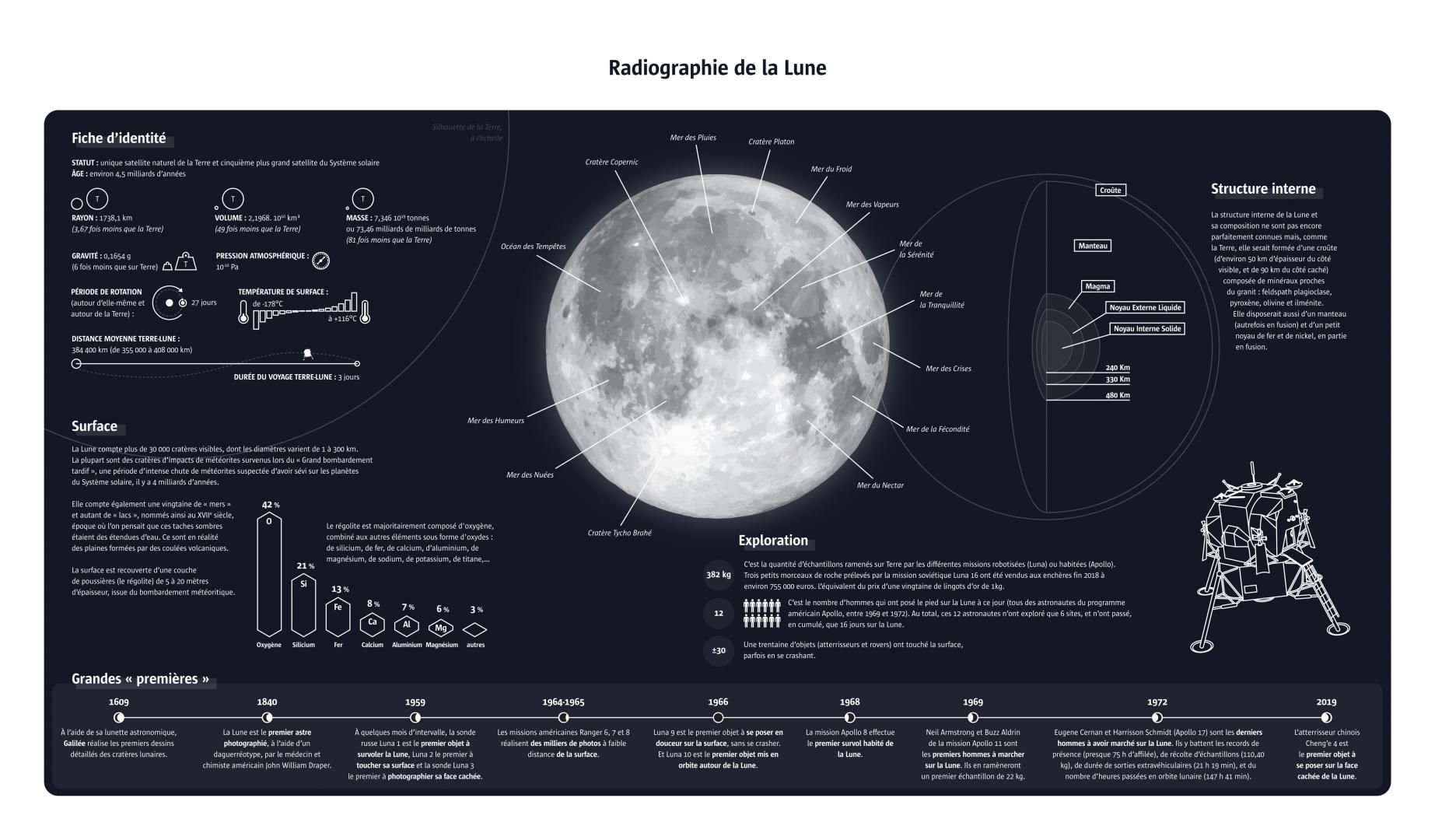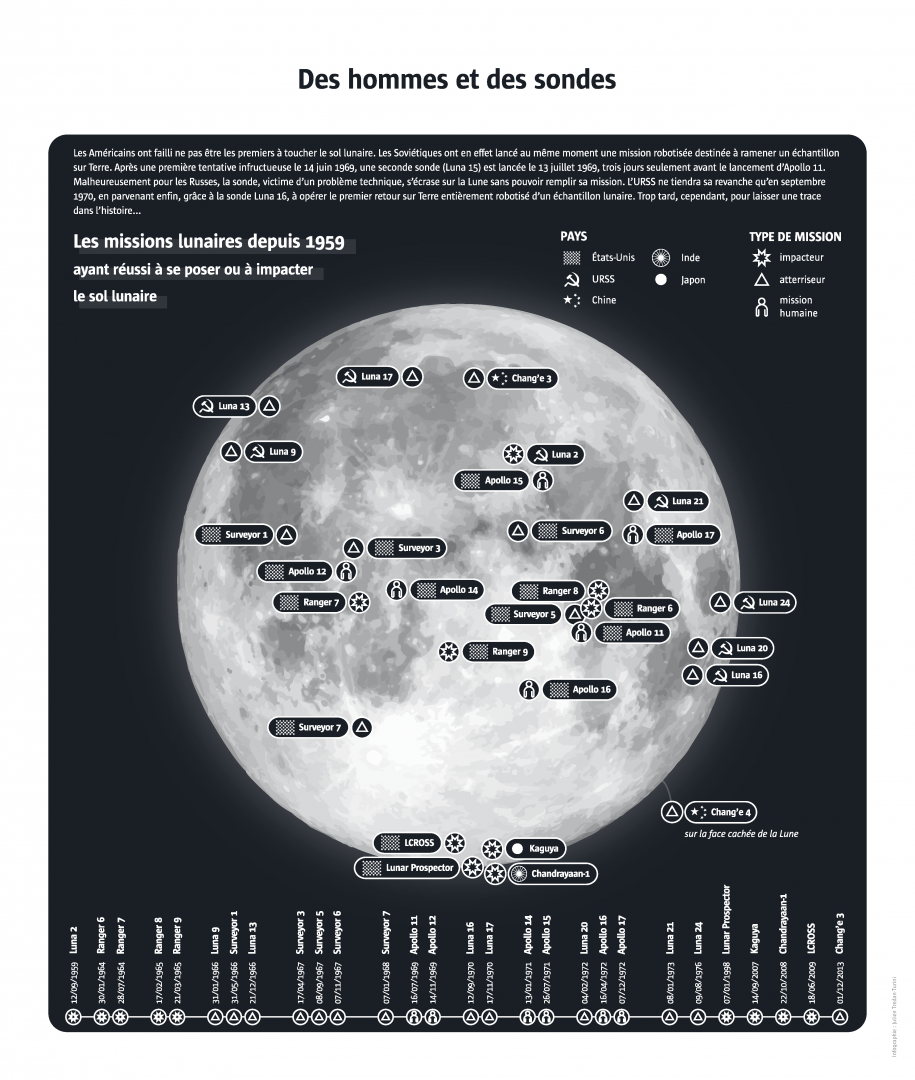
The Moon: 50 years . . . and now what?
As we celebrate the 50th anniversary of Neil Armstrong’s first ‘small step’ on the Moon, the Moon race is on again with space agencies around the world back on the move.
Texts by Pierre-Yves Bocquet - Published on
50 years after the ‘giant leap for mankind’ taken on 21 July 1969, the moon has not lost its appeal. Some countries are planning to put an object in its orbit, a probe or a space station. Others are intent on landing small unmanned vehicles, the famous rovers, on its surface. Still others have plans to set foot on the moon and even establish a permanent Moon base, which would be the first human settlement on a non-terrestrial body. The fact is our satellite is far from having delivered all its secrets: its formation, its composition, the quantity of water, and its minerals, for instance, are still unknown. In addition, the Moon is an ideal first step for further exploration of the Solar System, of Mars, in particular. Above all, the conquest of the Moon remains, 50 years after Apollo 11, a feat that many nations dream of adding to the list of their accomplishments, and thereby joining the very small circle of countries to boast such technological and economic superiority. Between science and geopolitics, the Moon continues to exert fascination over human beings.
In the Earthlight
This magnificent picture of the Earth seen from the Moon, with Africa and the Sahara Desert distinctly visible, was taken in 2015 by the American space telescope LRO (Lunar Reconnaissance Orbiter). It owes everything to chance, since the telescope is usually pointed to the lunar surface, and only rarely turns away from it, aiming at distant stars in order to perform instrument calibration measurements. It was precisely on one such occasion that Earth entered its field of view. This stroke of luck is all the more astonishing as the telescope at that precise moment was traveling at a speed of 1,600 meters per second, 134 kilometres above the surface of the Moon. That’s 5,760 kilometres per hour!
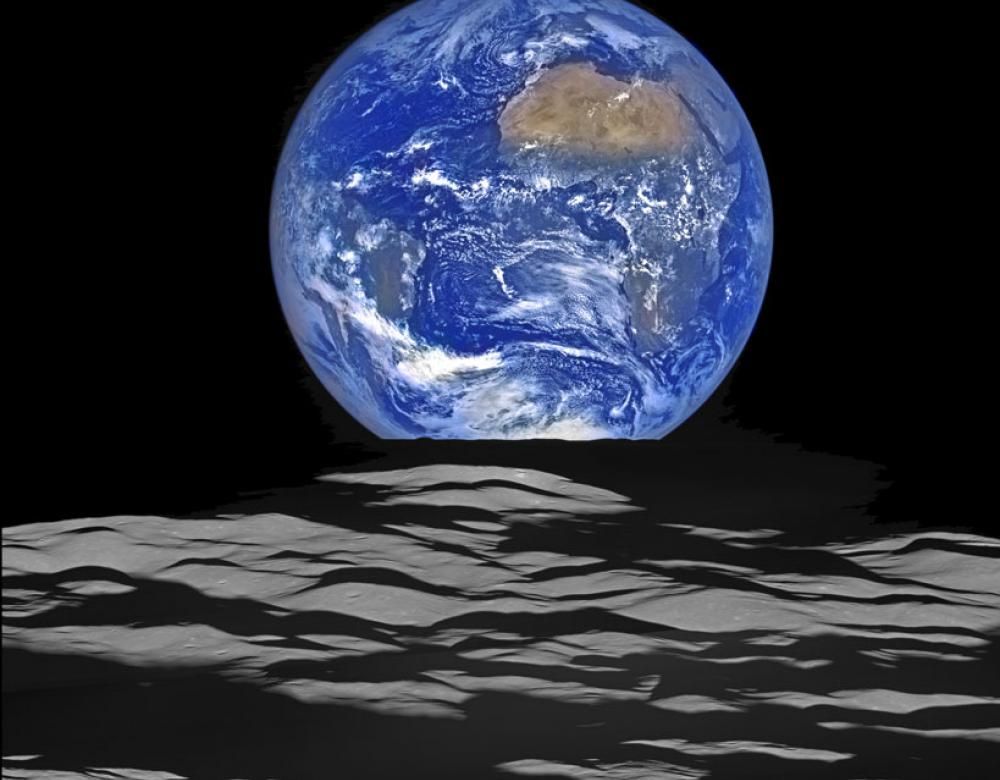
Apollo: the Americans retaliate
An outgrowth of geopolitical issues, the Apollo programme to conquer the Moon structured whole sectors of industry and research that remain active today.
It all started with the rivalry between the two great powers during the Cold War. Intent on regaining the upper hand on the international scene, after the USSR took the lead in the race for the first satellite (Sputnik, October 1957) and the first man in space (Gagarin, April 1961), in May 1961 President John Fitzgerald Kennedy announced the United States’ ambition to put a man to the moon – and bring him back to Earth – ‘by the end of the decade’. NASA, the young space agency created in 1958, was granted nearly unlimited resources: its budget was multiplied by 20 in 5 years (to reach 6 billion dollars in 1966, or 4% of the total United States budget), during which period it employed up to 376,000 people, recruited from industry and academia. These efforts contributed to structuring an entire American aerospace industry, with the assistance of major scientific institutions, such as the Massachusetts Institute of Technology (MIT), which participated in designing the lunar module navigation system. The Apollo programme, which achieved its goal on July 21, 1969 and would continue until 1972, made significant advances not only in our knowledge of the Moon, but also in all the disciplines involved in meeting this challenge. Some major examples include the birth of the first integrated circuit computer, huge advances in the planning and management of complex projects, enormous progress in the quality of lightweight and resistant materials, and the revolution in the development of sensors and instruments of unheard of precision.
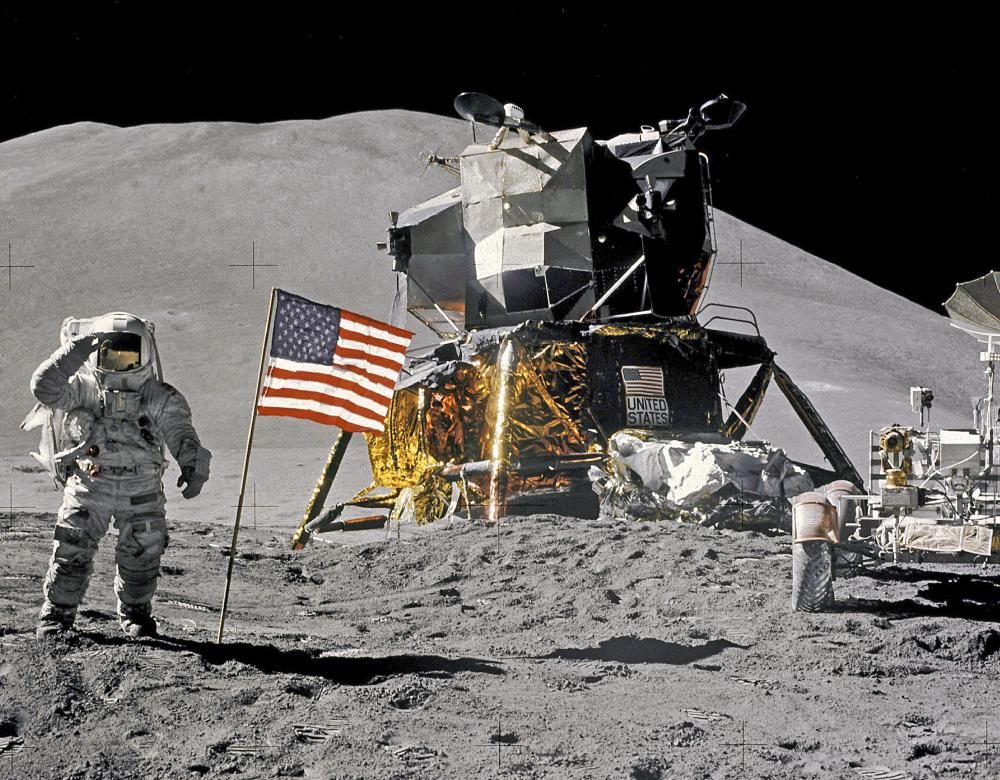
A magnet for crazy ideas
Ever since the Apollo programme, the Moon has remained a magnet for outlandish ideas that feed conspiracy theories. No sooner had the first American astronauts returned to Earth than some people began wondering why no stars were visible in any of the photos and why the American flag seemed to flutter even though the Moon has no atmosphere and consequently no wind. Despite the scientific explanations and the lunar rock samples brought back to Earth, hoax allegations regularly resurface on social networks. An Ifop poll of 1,760 people conducted in in France in December 2018 indicated that 9% of the French believe that no Americans ever actually walked on the Moon.
The future return of people to the Moon
Half a century after the end of the Apollo programme, the United States and China have announced plans to send people back to the moon in the next decade.
No human has stepped on the lunar ground since American astronauts Eugene Cernan and Harrison Schmitt from the Apollo 17 mission in December 1972. The only traces left there since have been from Russian robots (in 1974, 1975 and 1976) and Chinese robots (in 2013 and 2019). Several projects aim to renew the feat. A new international space station, called the Lunar Orbital Platform Gateway (led by the United States, but meant to involve other countries), to succeed the current ISS, will be put into orbit around the Moon at the end of the 2020s. It will make it possible to return more regularly and easily to our satellite. The current American government has set itself the goal of sending a man or woman back to the Moon in around 2028. This is a reversal of the strategy of the previous government that cancelled in 2010 the Constellation program launched by the Bush in 2004, whose goal was to enable long-term stays on the Moon by 2020. But the United States may not long remain the only country to have set foot on the moon: China officially announced its intention to put its first taikonaut on the lunar ground between 2025 and 2030. Its real means and technical capabilities are not known precisely but the country has consistently proved its ability to move forward at great speed since launching its first man into space in 2003. And it has so far kept to the schedule of its space program.
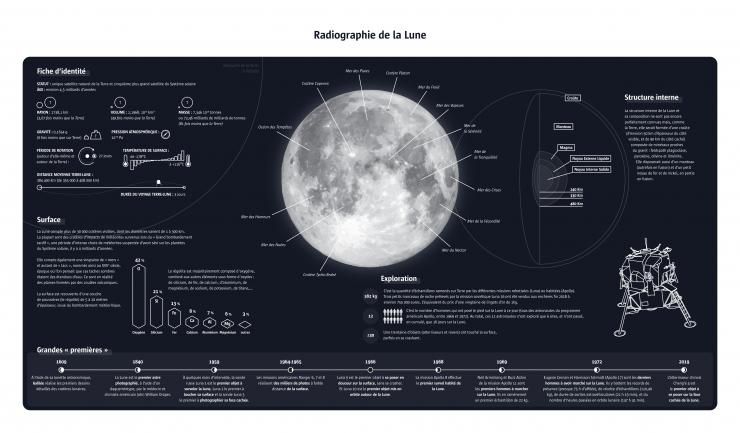
Still a Terra Incognita
Despite the many missions and the samples brought back to Earth, our satellite still holds many secrets.
From these decades of studies we have learnt a lot about our close neighbour: the composition of the thick layer of dust that covers it, the absence of a magnetic field, its gravity and more. But many mysteries remain, such as when the volcanic activity ceased that existed in the past, or the exact quantity of its resources – water of course, but also helium 3, a rare gas on Earth. Even its formation continues to be a subject of debate. The prevailing hypothesis is that it resulted from the collision of a massive body with the Earth more than 4 billion years ago, shortly after the birth of the Solar System. The impact ejected a large quantity of material, which eventually accumulated to form our satellite. The origin of this giant impact, and the mass and composition of the impacting body are still a matter of controversy as is the origin of the intense bombardment of meteorites, whose marks on the moon’s surface are still visible due to the lack of erosion. These impacts, some of which date to the formation of the planets, are a mine of information for understanding our Solar System and the Earth. A case in point is the study published in Earth and Planetary Science Letters in January 2019: the study of the composition of a rock sample brought back to Earth by the Apollo 14 mission in 1971 found that it is one of the oldest known terrestrial samples, over 4 billion years old. Uncovering the remaining secrets of the Moon will also help us gain a better understanding of Earth.
China carves its name in history
Land on the far side of the Moon, as the lander of the Chinese mission Chang’e 4 did on 3 January 2019, is a real technological challenge. Any direct communication with the Earth is impossible from there because radio waves are blocked by the Moon. China got around this difficulty by putting a satellite into orbit, in May 2018, on a position that is visible from both the Earth and the far side of the Moon. This allowed it, using a transceiver on board, to act as a radio relay between the Earth, the lander and the small rover – a feat that was hailed by NASA and other international agencies.
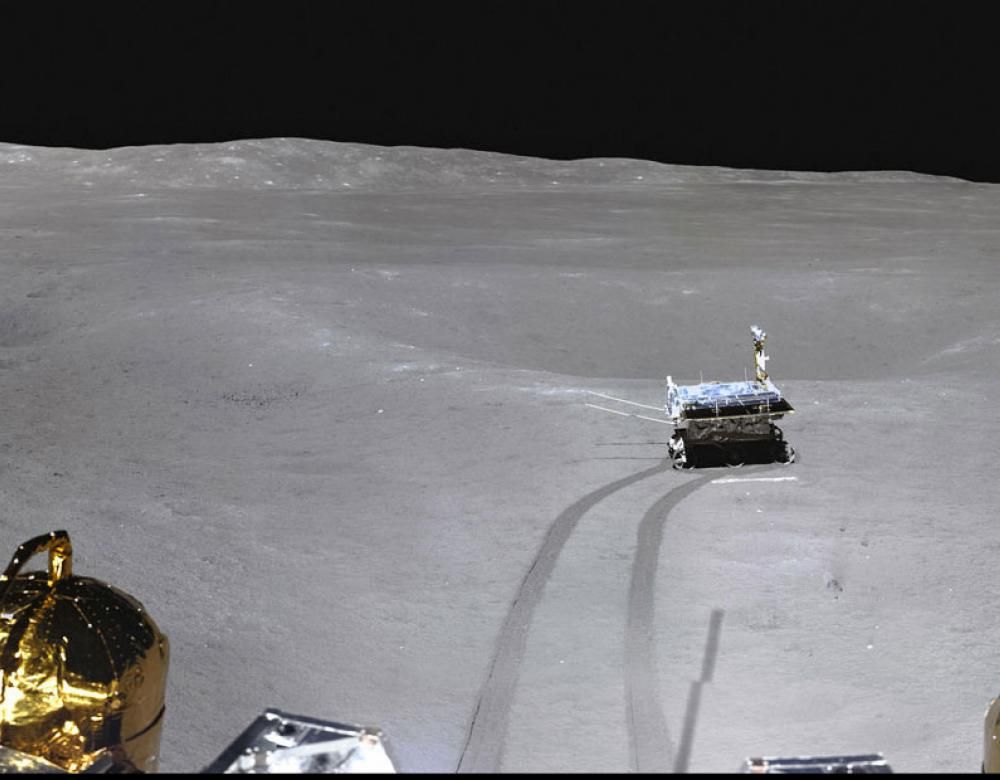
International geopolitical stakes
Behind the lunar ambitions lie power struggles between the few countries capable of accomplishing such technical feats.
The recent revival of interest in the Moon is not solely motivated by a thirst for knowledge. There are also major geopolitical issues at stake, as there were at the time of the Apollo program. Then the competition was between the United States and the Soviet Union; now it involves more and more countries. The former USSR has left its place in the contest to China, which accomplished the feat in January 2019 of landing a small robot on the dark side of the Moon. Other countries are also planning a return to the Moon using robotic probes, less dangerous and costly than ‘manned’ missions. Starting with Israel, which launched its first probe to the Moon in February 2019. India is also scheduled to launch a robotic mission in April 2019, including a rover equipped with spectroscopes to study the lunar surface and Japan will follow suit in a year with the intention of exploring an ancient volcanic area. South Korea also announced its space exploration ambitions, with the launch of its first lunar probe, planned for late 2020, to study the lunar topography. In another sign of the times, private actors are entering the race for the purpose of pulling off a remarkable feat and gaining credibility. The Israeli mission, the first built entirely on private funds, will probably not be the last. The private American aerospace corporation SpaceX is planning to fly tourists to the Moon and back again, following the trajectory of Apollo 8 (1968). But without landing on the Moon.

Scientific baggage
All of the six Apollo missions that landed on the Moon carried a load of scientific instruments to probe the environment: composition of the atmosphere, soil and subsoil, measurement of cosmic radiation, magnetic field, gravity, etc. These instruments (seismometers, gravimeters, laser reflectors, particle sensors, etc.) were part of the ‘Apollo Lunar Surface Experiments Package’ (ALSEP), different for each mission and deployed on the ground at each landing site. But the really ambitious scientific experiments were not conducted until Apollo missions 15, 16 and 17 (1971–1972), using instruments such as the magnetometer (seen here) of the Apollo 16 mission. Most of these instruments were left on the Moon by the astronauts and continued to send data until 1977.
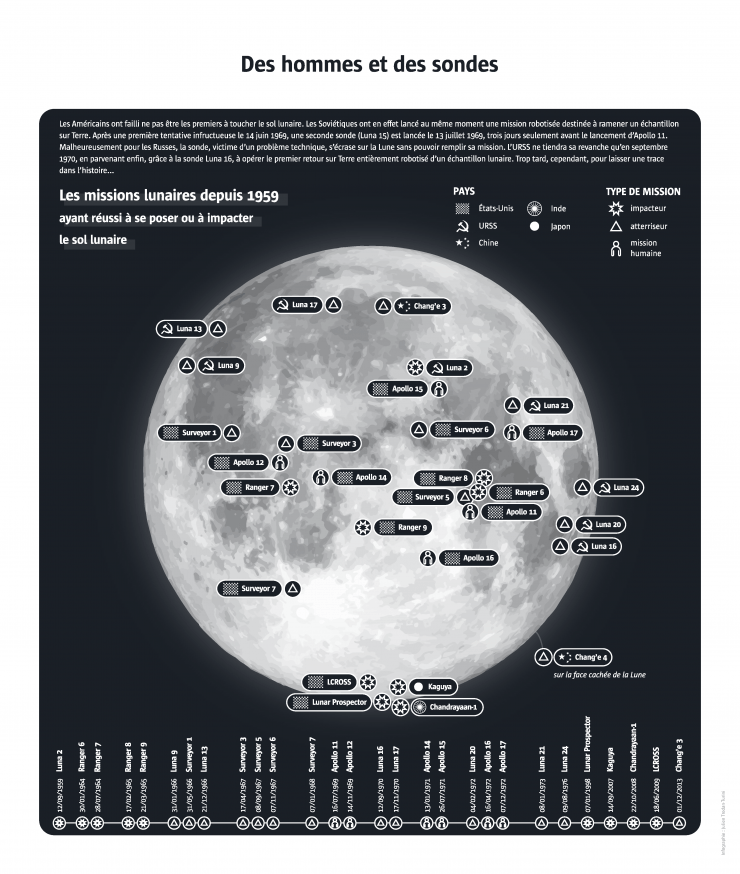
A base camp for Mars?
More representative of living conditions in space than the current International Space Station, the Moon is the ideal place to prepare for a trip to Mars.
Why set ourselves the goal of returning to the Moon when, in addition to having already been there 50 years ago, multiple probes have flown over it from all angles and rovers have explored its surface several times? Simply because the goal now is no longer to take a few steps on the surface of our satellite – the longest stay lasted only 75 hours, during the Apollo 17 mission – but rather to set up a sustainable human presence in orbit or on the surface. This represents an unprecedented technical and human challenge: since the Moon’s atmosphere is very thin and it has no magnetosphere, it is fully exposed to cosmic radiation from stars – including the Sun – which are hazardous to health in case of prolonged exposure. Not very dangerous for short trips, like the Apollo missions, this toxic radiation represents one of the main challenges for future space travel to more distant destinations. The Moon is therefore an ideal training ground to test the technologies and conditions of human survival that would be implemented during a trip to Mars, which is the announced objective of both the United States and China in the coming decades. This is why the lunar orbit was chosen for the future international space station that will take over in the late 2020s from the ISS currently in orbit around the Earth. So even though the Moon will no longer be the main objective, it will participate once again in the future ‘giant leap for mankind’. On condition that the Martian goal is confirmed.
The European Moon base project
One of the major projects spearheaded by Johann-Dietrich Wörner, president of the European Space Agency, is to build an inhabited base on the Moon. To shelter the inhabitants and protect them from the toxic effects of cosmic radiation, without having to launch huge amounts of materials into space, ESA researchers are looking into the possibility of using lunar dust as a building material. How? Robotic devices would be deployed to crush the dust and compress it with 3D mobile printers. Tests conducted on Earth, in a vacuum, have demonstrated the effectiveness of the method. But so far there is no timetable or budget for the implementation of this project.
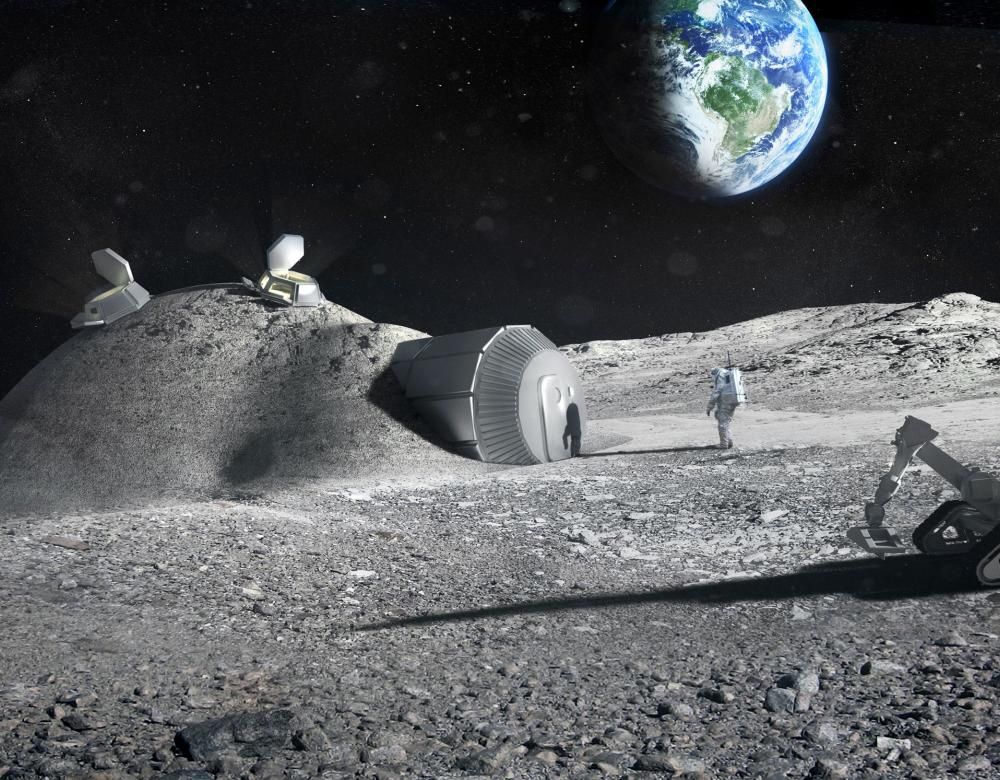

Why go to the dark side of the moon?
Returning to the Chinese mission Chang’e-4, Francis Rocard, astrophysicist in Cnes, illuminates us on the dark side of our satellite.
In french.
